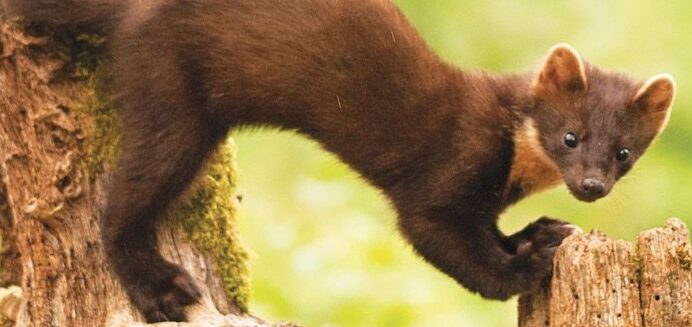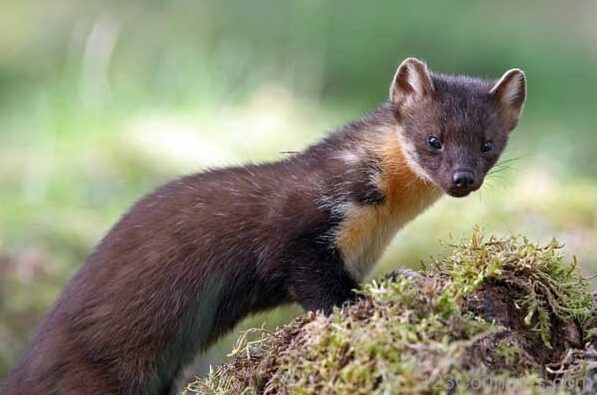Marta is national animal of Croatia. Croatian national animal has small-headed mustelid, long tail and soft, thick brown hair with a yellow or white spot on the throat, which feeds on birds, eggs, and rodents; lives in the forests of Europe and is highly prized for its skin.

National Animal of Croatia
Behavior
It is very well adapted to life in the forest, climbing nimbly and jumping with spectacular precision between the branches of the trees. Among their well-developed senses, they emphasize the exceptional smell and hearing they possess. Normally on the ground, it jumps. He also knows how to swim, although he refuses to do so.
When he gets scared he emits screams and grunts and dismisses a viscous substance of unpleasant odor, more intense during the heat, which normally uses to mark the territory. After hunting a prey, it moves it to its burrow, and if it were big or very heavy, it will drag it to a safe place where to eat it with tranquility. With the exception of the season of zeal, the marten is a solitary animal whose activity runs throughout the year and usually between dusk and dusk, being able to observe during the zeal also during the day, more often than the garden. During the day it is encased in hollows of trees, nests of corvids, birds of prey, or squirrels.
Interesting facts about Marten
Physical characteristics
It is a carnivorous mammal belonging to the family of mustelids and closely resembles the marten (Martes foina), differing from this in the triangular orange spot that it has in the throat.
His body is elongated, his head wide, his ears small and rounded, and the muzzle sharp. The legs are short, provided with 5 fingers, darker than the coat and the hair completely covers the soles of the feet. The tail is long and thick, well populated with hair and its length varies between 22 and 27 cm. The head together with the body of the marten, usual measures between 42 and 52 cm, reaching the males a weight of 1.2 to 2 kg, and females between 0.9 and 1.5 kilograms.
Do You want to know about a National animal of Cote d’Ivoire?
The general color is dark brown, lighter by the belly and darker by the legs. A more or less triangular, bib-shaped spot appears on the neck, which may be creamy, yellow or orange, which is most clearly visible outside the summer season. The color of his eyes is dark, and the color of his nose, black. The ears are bordered by a very light color.
It has a total of 38 teeth, being observed in the upper jaw 6 incisors, 2 fangs, 8 premolars, and 2 molars, and in the lower one, 2 more molars.
Distribution
It is distributed throughout most of the European continent from Scandinavia to some islands of the Mediterranean and Asia Minor as well as the North of the British Isles. It finds the southern limit of its distribution area in the Iberian peninsula, where it only appears in a strip that goes from the north of Portugal to the north of Lerida.
In Spain, there is another subspecies, that inhabits in Majorca and its general coloration is paler and in the Balearic Islands exists a subspecies, the Tuesday minoricensis.

Habitat
Its habitat is linked to large forests, especially those of conifers, also occupying mixed forests, beech forests, oak forests, etc.
It lives in the deepest part of the forest, separated from the human environment, where it has its territory, which can travel in a single night and in which are the multiple cubiles located in hollows of trees, squirrel nests, birds, between stones, etc.
It adapts to life from sea level, up to 1,700 meters of altitude.
Feeding
The marten can be fed from birds and their eggs to the size of the grouse, squirrels, dormouse, rats, mice, reptiles, rabbits and hares, amphibians, poultry, eggs, fruits, honey, insects and larvae, Roe deer.
The eggs eat them in a characteristic way, making them an elongated hole, almost rectangular, where the content is sucked. Sometimes if the eggs are many, you can bury some under the moss, the vegetation. When hunting an animal, it begins by drinking its blood, with which the excrement pertaining to that food, will present a black color.
Reproduction of Croatian National Animal
There could be two periods of zeal, one of them during the winter, which according to various authors does not correspond with a real zeal, but with a period of excitement or false zeal.
The royal seal of the Marta can take place between the months of June and August and lasts about 15 days. During this period, more movement is observed within the territories, being put together several males to the dispute to the female. The winning male will play and fight with the female, in a true nuptial stop, and after fertilizing it, will abandon her.
The female will keep the male’s sperm alive in the uterus, but will not fertilize them until the month of January (delayed implantation), having a real gestation lasting about 9 weeks.











